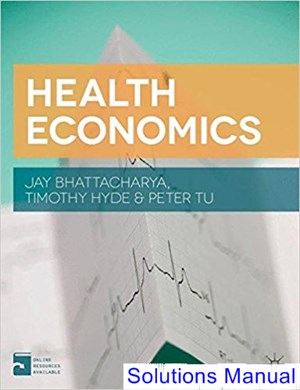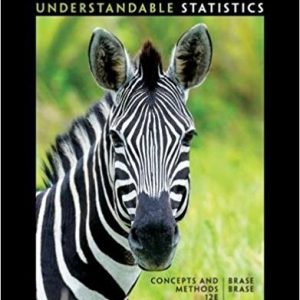This is completed downloadable of Health Economics 1st Edition Bhattacharya Solutions Manual

Product Details:
- ISBN-10 : 113702996X
- ISBN-13 : 978-1137029966
- Author:
Comprehensive in coverage this textbook, written by academics from leading institutions, discusses current developments and debates in modern health economics from an international perspective. Economic models are presented in detail, complemented by real-life explanations and analysis, and discussions of the influence of such theories on policymaking. Offering sound pedagogy and economic rigor, Health Economics focuses on building intuition alongside appropriate mathematical formality, translating technical language into accessible economic narrative. Rather than shying away from intellectual building blocks, students are introduced to technical and theoretical foundations and encouraged to apply these to inform empirical studies and wider policymaking. Health Economics provides: – A broad scope, featuring comparative health policy and empirical examples from around the world to help students relate the principles of health economics to everyday life – Coverage of topical issues such as the obesity epidemic, economic epidemiology, socioeconomic health disparities, and behavioural economics – A rich learning resource, complete with hundreds of exercises to help solidify and extend understanding. This book is designed for advanced undergraduate courses in health economics and policy but may also interest postgraduate students in economics, medicine and health policy.
Table of Content:
- 1. Why health economics?
- 1.1 The health care economy is massive
- 1.2 Health is uncertain and contagious
- 1.3 Health economics is public finance
- 1.4 Welfare economics
- 1.5 A special note for non-American readers
- I: Demand for health and health care
- 2. Demand for health care
- 2.1 Experiments on the demand for health care
- 2.2 Is demand for health care downward-sloping?
- 2.3 Measuring price sensitivity with elasticities
- 2.4 Does the price of health care affect health?
- 2.5 Conclusion
- 2.6 Exercises
- 3. Demand for health: the Grossman model
- 3.1 A day in the life of the Grossman model
- 3.2 An optimal day
- 3.3 Extending Grossman from cradle to grave
- 3.4 Comparative statics
- 3.5 Unifying the Grossman model
- 3.6 Conclusion
- 3.7 Exercises
- 4. Socioeconomic disparities in health
- 4.1 The pervasiveness of health inequality
- 4.2 The Grossman model and health disparities
- 4.3 The efficient producer hypothesis
- 4.4 The thrifty phenotype hypothesis
- 4.5 The direct income hypothesis
- 4.6 The allostatic load hypothesis
- 4.7 The productive time hypothesis
- 4.8 Time preference: the Fuchs hypothesis
- 4.9 Conclusion
- 4.10 Exercises
- II: Supply of health care
- 5. The labor market for physicians
- 5.1 The training of physicians
- 5.2 Physician wages
- 5.3 Barriers to entry
- 5.4 Physician agency
- 5.5 Racial discrimination by physicians
- 5.6 Conclusion
- 5.7 Exercises
- 6. The hospital industry
- 6.1 The rise and decline of the modern hospital
- 6.2 The relationship between hospitals and physicians
- 6.3 The relationship between hospitals and other hospitals
- 6.4 Nonprofits and hospital production
- 6.5 The relationship between hospitals and payers
- 6.6 Conclusion
- 6.7 Exercises
- III: Information economics
- 7. Demand for insurance
- 7.1 Declining marginal utility of income
- 7.2 Uncertainty
- 7.3 Risk aversion
- 7.4 Uncertainty and insurance
- 7.5 Comparing insurance contracts
- 7.6 Conclusion
- 7.7 Exercises
- 8. Adverse selection: Akerlof’s market for lemons
- 8.1 The intuition behind the market for lemons
- 8.2 A formal statement of the Akerlof model
- 8.3 The adverse selection death spiral
- 8.4 When can the market for lemons work?
- 8.5 Conclusion
- 8.6 Exercises
- 9. Adverse selection: the Rothschild–Stiglitz model
- 9.1 The IH–IS space
- 9.2 Indifference curves in IH–IS space
- 9.3 The full-insurance line
- 9.4 The zero-profit line
- 9.5 The feasible contract wedge
- 9.6 Finding an equilibrium
- 9.7 Heterogeneous risk types
- 9.8 Indifference curves for the robust and the frail
- 9.9 Information asymmetry and the pooling equilibrium
- 9.10 Finding a separating equilibrium (sometimes)
- 9.11 Can markets solve adverse selection?
- 9.12 Conclusion
- 9.13 Exercises
- 10. Adverse selection in real markets
- 10.1 Predictions of asymmetric information models
- 10.2 Adverse selection in health insurance
- 10.3 Adverse selection in other markets
- 10.4 What prevents adverse selection?
- 10.5 Conclusion
- 10.6 Exercises
- 11. Moral hazard
- 11.1 What is moral hazard?
- 11.2 A graphical representation of moral hazard
- 11.3 How to limit moral hazard
- 11.4 Evidence of moral hazard in health insurance
- 11.5 The tradeoff between moral hazard and risk reduction
- 11.6 The upside of moral hazard?
- 11.7 Conclusion
- 11.8 Exercises
- IV: Economics of health innovation
- 12. Pharmaceuticals and the economics of innovation
- 12.1 The life cycle of a drug
- 12.2 The uncertainty and costs of drug development
- 12.3 Patents
- 12.4 Induced innovation
- 12.5 Regulation of the pharmaceutical industry
- 12.6 Conclusion
- 12.7 Exercises
- 13. Technology and the price of health care
- 13.1 Technology and the rise in medical expenditures
- 13.2 New technology and medical inflation
- 13.3 Technology overuse: the Dartmouth Atlas
- 13.4 Theories to explain the Dartmouth findings
- 13.5 Conclusion
- 13.6 Exercises
- 14. Health technology assessment
- 14.1 Cost-effectiveness analysis
- 14.2 Evaluating multiple treatments: the cost-effectiveness frontier
- 14.3 Measuring costs
- 14.4 Measuring effectiveness
- 14.5 Cost–benefit analysis: picking the optimal treatment
- 14.6 Valuing life
- 14.7 Conclusion
- 14.8 Exercises
- V: Health policy
- 15. The health policy conundrum
- 15.1 Arrow’s impossibility theorem
- 15.2 The health policy trilemma
- 15.3 How should health insurance markets work?
- 15.4 How should moral hazard be controlled?
- 15.5 How should health care provision be regulated?
- 15.6 Comparing national health policies
- 15.7 Conclusion
- 15.8 Exercises
- 16. The Beveridge model: nationalized health care
- 16.1 A brief tour of the Beveridge world
- 16.2 Rationing health care without prices
- 16.3 Queuing
- 16.4 Health technology assessment
- 16.5 Competition in Beveridge systems
- 16.6 Injecting competition
- 16.7 Conclusion
- 16.8 Exercises
- 17. The Bismarck model: social health insurance
- 17.1 A brief tour of the Bismarck world
- 17.2 Health insurance markets in the Bismarck model
- 17.3 Containing costs with price controls
- 17.4 Conclusion
- 17.5 Exercises
- 18. The American model
- 18.1 Employer-sponsored health insurance
- 18.2 The managed care alternative
- 18.3 Medicare: universal coverage for the elderly and the severely disabled
- 18.4 Medicaid: subsidized coverage for the poor
- 18.5 Uninsurance
- 18.6 2010 health reform
- 18.7 Conclusion
- 18.8 Exercises
- 19. Population aging and the future of health policy
- 19.1 Why is the world aging?
- 19.2 Health care system sustainability
- 19.3 Forecasting the future of health expenditures
- 19.4 Policy responses to population aging
- 19.5 Conclusion
- 19.6 Exercises
- VI: Public health economics
- 20. The economics of health externalities
- 20.1 Externalities in health
- 20.2 Pigouvian subsidies and taxes
- 20.3 The Coase theorem
- 20.4 The economics of organ transplantation
- 20.5 Conclusion
- 20.6 Exercises
- 21. Economic epidemiology
- 21.1 The demand for self-protection
- 21.2 The SIR model of infectious disease
- 21.3 Disease control
- 21.4 Applications of economic epidemiology
- 21.5 Conclusion
- 21.6 Exercises
- 22. Obesity
- 22.1 The widespread rise in obesity
- 22.2 What explains increasing obesity?
- 22.3 The costs of obesity
- 22.4 Is obesity a public health crisis?
- 22.5 Obesity contagion in social networks
- 22.6 Other justifications for public health intervention
- 22.7 Conclusion
- 22.8 Exercises
- VII: Behavioral health economics
- 23. Prospect theory
- 23.1 Modeling decisions under uncertainty
- 23.2 Misjudging probabilities
- 23.3 Framing
- 23.4 Loss aversion
- 23.5 A formal introduction to prospect theory
- 23.6 Implications for health economics
- 23.7 Conclusion
- 23.8 Exercises
- 24. Time inconsistency and health
- 24.1 The beta-delta discounting model
- 24.1 The beta-delta discounting model
- 24.2 Time-consistent preferences
- 24.3 Time-inconsistent preferences: myopia and hot brains
- 24.4 Demand for commitment mechanisms
- 24.5 Behavioral welfare economics
- 24.6 Conclusion
- 24.7 Exercises
- Bibliography
- List of figures
- List of tables
- Index





